STUDIO/SEMINAR-FINAL PROJECT
A COLORFUL FEAST
WEEK ONE
STUDIO: Food brings cultures together. Using this hypothesis as a base, I’m planning to create a dinner table out of a canvas by placing plates that reflects every culture’s art and design( for example the plate that reflects the Turkish culture and art will be designed with traditional ottoman patterns). There will be 8 plates that represent 8 cultures. I’m going to work with the ones that are most distinguishing;
After placing the plates on the table (canvas), I’m planning to set the table with food that represents each culture’s cuisine. The most important aspect of this settlement will be that every food that represent a specific culture will be on another culture’s plate. For example, sushis will be served on a plate that represents the Italian culture and art. At the end, the overall piece will show that every culture can be integrated and that integrated cultures forge the universe.
-MY INSPIRERS- BRIDGE 2 AND BRIDGE 3
Throughout the semester, I’ve tried to reflect my thought about people with different backgrounds, thoughts, colors, ages, nationalities, ethics and I’ve tried to use my thoughts while I was creating my bridge projects. For that I wanted to bring out a final piece that has the essence of my past bridge projects and the color wheel project that we did in class.
The rainbow is a part of nature, and you have to be in the right place to see it. It’s beautiful, all of the colors, even the colors you can’t see. That really fit us as a people because we are all of the colors. Our sexuality is all of the colors. We are all the genders, races, and ages.
-GILBERT BAKER
SEMINAR :I’m going to write about how food unifies people from different backgrounds/ how food brings cultures together. I’ll make research about artworks that reflect the same topic. For example I’ll look at the french artist JR’s giant picnic table at the southern border of the US which makes it possible for people to share the same meal as if there is no wall. Also, I’ll include informations about “The Conflict Kitchen” which is a restaurant at Pittsburg that serves food from the countries with which the US is in conflict. It aims to bring people from different background together to share their cultural identity and their stories in spite of the conflicts . I’ll also include my personal additions and the importance of sharing food in Turkish culture in terms of unity and to strengthen the relationships.
WEEK TWO (4/10)
Studio: After Emily and I talked about the idea, instead of painting the plates, I’ve decided to paint all the patterns from the different countries into one tablecloth to emphasize more about unity and intermixing. I’ve decided to use real plates to make the work more authentic (I’m going to buy them from a thrift shop) and to place them on the designed tablecloth.
Seminar: I came up with the THESIS STATEMENT of my essay and I’ve started to work on the introduction.
THESIS IDEAS
1-) Food has a role of setting up identities, and the consumed identities gathers diverse communities under a single roof.
2-) Food as a sort of vehicle builds relationships in diverse communities, strengthens connectedness, and at the same time helps spread global awareness of different cultures and political practices.
3-) The way food is gathered, prepared, presented, and shared varies across cultures and understanding these customs are important in a globalized world, where all cultures are integrated.
-After having my class mates thoughts we’ve decided that first one is more powerful in summarizing what I’m going to write about.
WEEK THREE (4/17):
Studio: We had a studio class this week and I started to work on my tablecloth. The first thing that I’ve done was to draw to the motifs on a canvas and to arrange them. I placed the fish motifs around the canvas as if they they are moving in a circular direction. I connected every single motif with diagonal lines to emphasize intermixing and connectedness. My overall aim behind my arrangement was to show that beauty can still be maintained by integrating different shapes/ different cultures/ different backgrounds.
Seminar: I finished my Introduction. So I decided to include my family and our family meal time memories to create a sincere atmosphere and to entertain and my reader before I give facts about the topic. I wanted my reader to be able to visualize our family meal times in Turkey as if they are witnessing it.
A diverse group of seven people. Filipinos, Uzbeks, Turks and Norwegians. All with different cultures, age groups and professions. Since 1999, the year when I was born, a minimum of three out of seven days a week, we’ve gathered around the table for family dinners or for Sunday breakfasts.
At the head of the table sits my mom, a serious looking householder. When she starts talking, the seriousness is gone. She sits there so that she could set the table and serves the food easily. On one side of her, sits my sister, Alara with her Norwegian boyfriend, Can. Alara is five years older than me yet her baby face makes her look younger. She met Can four years ago on her trip to Oslo; since then he’s been adding diversity to our family. As soon as we start a conversation, Can passionately talks about Norwegian cuisine and makes us taste their traditional food. Most recently, he made us taste the Norwegian caviar that he had brought from Norway.
Next to me, sits our Uzbek home helper, Ferida, a 29-years-old woman with a deep voice who helps my mom with some simple household chores like house keeping and cooking. Since I was very little, she has been cooking traditional Uzbek food; in fact, even though they don’t celebrate Christmas in her home country, she’s been cooking our Christmas turkey by adding an essence from her cultural background. I can’t forget the delicious taste of turkey that she cooks and serves with Uzbek pilaf. She has brought joy to our family meal time with her cultural contributions.
Next to her sits our other helper Marilyn, who is from Philippines and who has been my mom’s second hand while she’s been raising me; having her beside me at a young age, I had the opportunity to learn about her culture before mine. Moreover, I learned how to speak Filipino before I learned my mother language, Turkish. I remember asking her repeatedly to cook vegetable noodles -it’s called pansit in Filipino cuisine – for lunch, and fried rice for dinner. When I was little, she introduced me to soy sauce and since then I’ve started to pour soy sauce on whatever I eat. I used to embrace Filipino culture as if I was born there.
Right next to her, sits my aunt, Emel who is a traditional Turkish woman from the east side of Turkey. She is fond of telling stories from Turkish culture and telling our fortunes by looking at our coffee cups’ ground. Whenever we gather for a family meal time, she’s always brought a homemade dish that she cooked in a way that my grandmother used to cook and had taught her. She loves informing us about the forgotten traditional folk recipes and she’s been putting us in charge of transmitting those recipes to future generations in order to maintain our cultural continuation and cultural heritage. Moreover, she believes that dining table is a place of socialization. She says that both gathering around the dinner table and sharing food should be considered as gains of the socialization process, and these gains are an important indicator of the cultural identity of societies.
As these seven people bring diversity to the table, I’ve observed that gathering for food actually strengthens relationships by integrating different cultural backgrounds. As this array of nationalities, ethics, beliefs, cultures, professions, is what makes our talks at the dinner table unique, it’s also what makes me a mature young woman today.
Week 4
Studio: I’m done with the table cloth. Throughout the week I painted the shapes that I drew in class. I added more motifs to make it more appealing and I re-painted the ones that I’m not sure with their colors.
Final version of my table cloth that includes;
- Turkish motifs:tulips
- Italian motifs; purple flowers
- Japanese motifs: orange fishes
- Chinese motifs: blossoms
- French motifs: blue shapes
- Mexican motifs: pink-purple suns
- Moroccan motifs; turquoise flourish shapes
Seminar: I made a research about some artworks that focuses on food-culture-unity-relationship…
Conflict Kitchen- It is a restaurant in Pittsburg which allows sharing food and culture of the countries with which the US is in conflict and allows people from those countries to share their perspectives on economic and environmental conflict. It is a beneficial source to explore since the project aims to use food as a sort of vehicle to help spread global awareness of different cultures and political practices.
JR’s Giant Picnic- The giant installation make it possible for people to share the same meal as if there is no wall, and increase global awareness on unity in diversity. Examining the piece is necessary, in order to observe a real life example of feast that is used to bring people together.
Week 5
FINAL DOCUMENTATION
I wanted to create a feast table that includes many cultures traditional food. The most important part of my piece is the table cloth that I designed by merging the traditional motifs of different cultures. My overall purpose behind this idea is to prove that beauty can be maintained by integrating different cultures and to show that food has a role of setting up identities and when people gather around a table to eat food, consuming those identities helps building up relationships between people.
Every culture has its own way to prepare, to present and to share food. In a globalized world, food connects us to people from all around the world. Understanding and experiencing these customs are important because in these days every culture is integrated somehow.

CHOOSING WHICH FOOD TO SERVE :




When you sit at the same table with people with different nationalities, food can be a great conservation starter bc everybody loves talking about their traditional food and at the same time everybody loves hearing about different food and tasting food.
In my essay, I wrote about our family meal times in Turkey. I described my diverse family and how having cultural diversity at home is effecting me. In brief, we have 2 home helpers in our home one is from Uzbekistan an the other is from Philippines, since I know myself they have been informing me about their culture and they’ve been cooking their traditional food for us.
Also my sister’s boyfriend is from Norway. He is so passionate about food and loves talking about Norwegian cuisine…
Sitting at the same table with all of these people, make me observe how conversations can be started through food.
Throughout my essay I also mentioned two artists that highlights the fact that food is an essential tool in order to build up relationships and to maintain unity.
The french artist JR’s giant picnic table at the us and Mexico border. The giant installation make it possible for people to share the same meal as if there is no wall, and increase global awareness on unity in diversity.
Conflict Kitchen which allows sharing food and culture of the countries with which the US is in conflict and allows people from those countries to share their perspectives on economic and environmental conflict.
PRESENTATION DAY
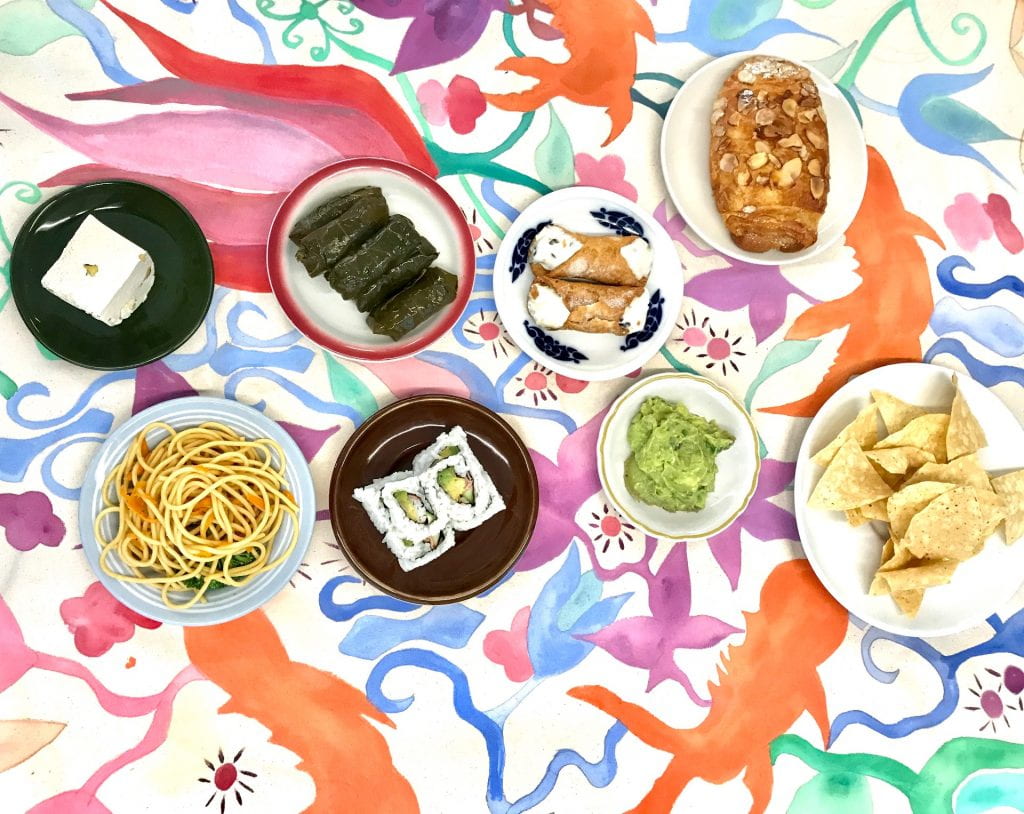
I really liked the way the plates and the food looks on the tablecloth. I think even the food’s color matched with the motifs that are on the tablecloth. I’m satisfied with my classmates positive comments and also I’m so happy that I could make them taste the Turkish food that I brought.
FUTURE PLANS
After I presented my my piece, I realized that there are some limitations that I have to improve (such as not including so many cultures) so I’ve started to think about how to improve and update my piece for the future. I thought that if I include more cultures and more food that represents each culture, it would be more universal. Also rather than a 20×20 inch tablecloth, I can expand the size of the table cloth and exhibit the overall piece in a more public area such as a park or a festival. I thought that if I can set my feast table at a festival where kids are involved, it would be more beneficial in terms of informing kids about traditional food and their way of connecting diverse communities.



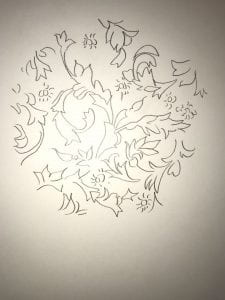
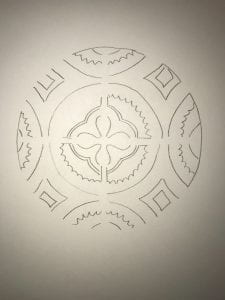

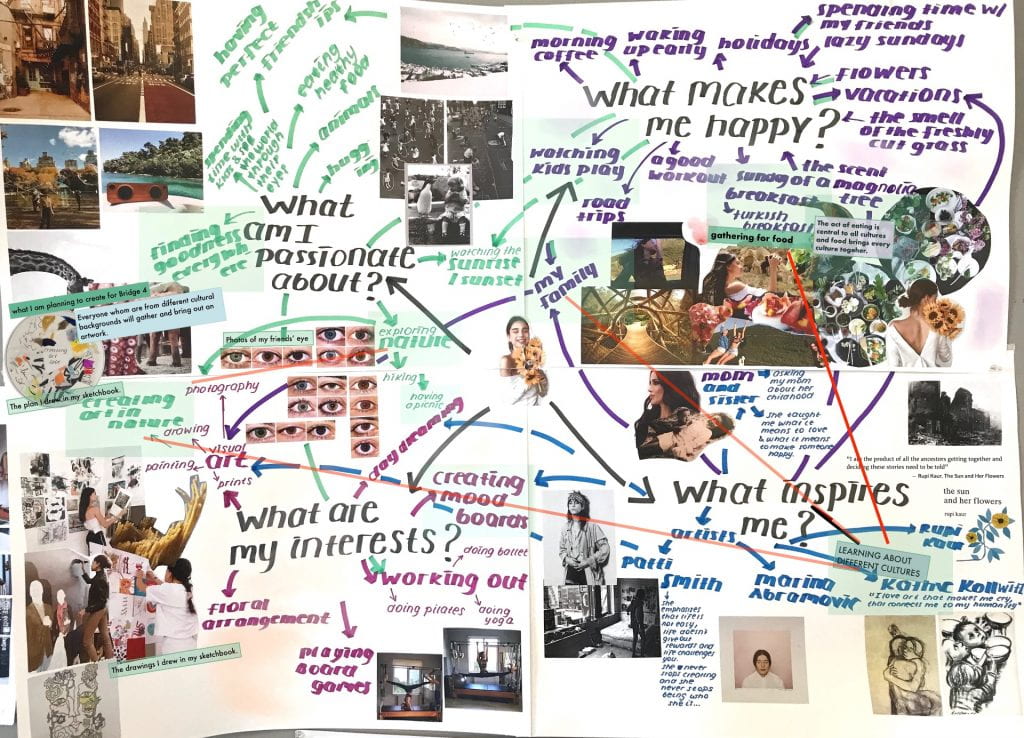
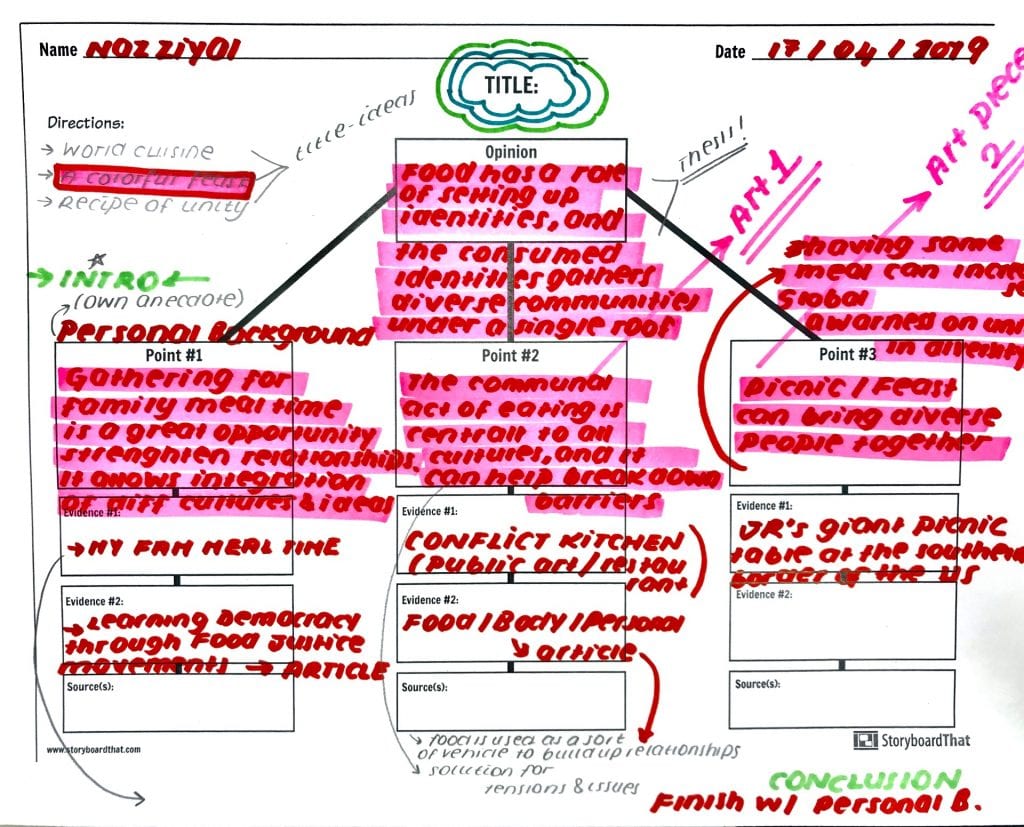
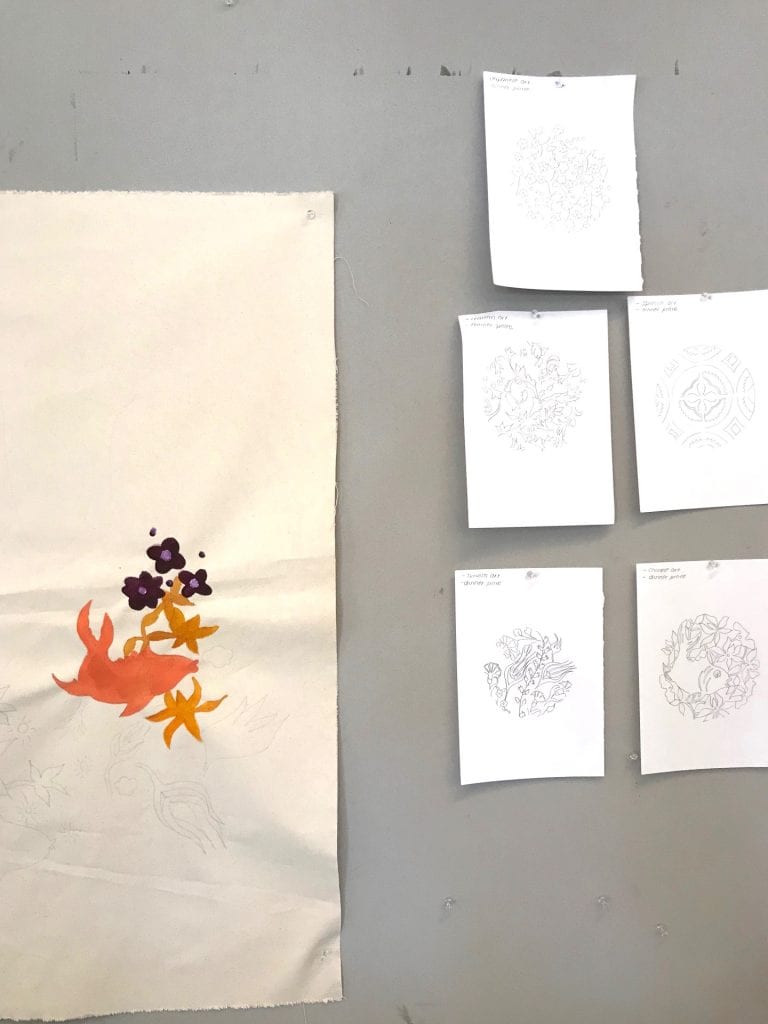


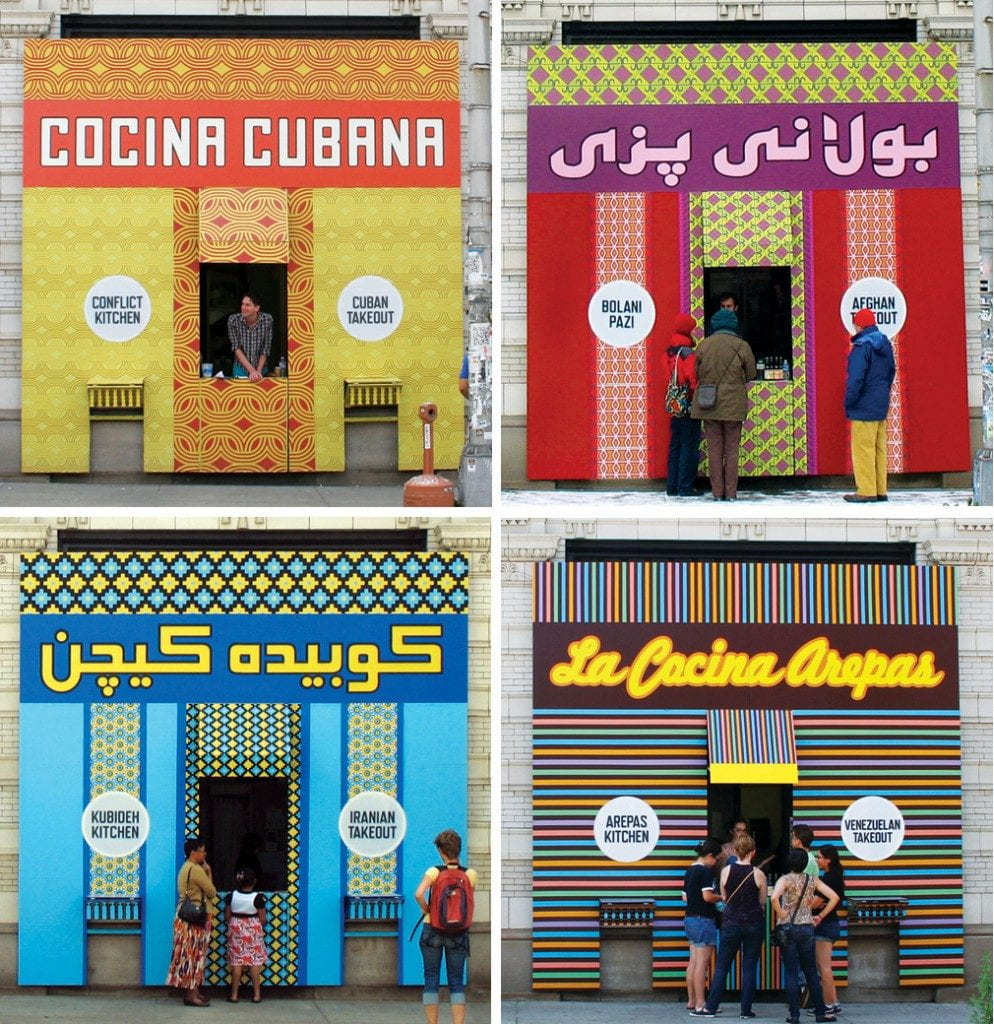


Comments